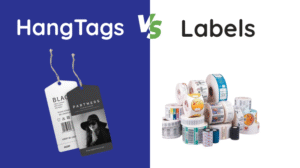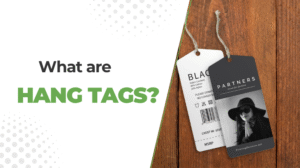Shoppers rarely stop for long at event booths or pop-up stores. With so many brands competing for attention, products can blend into the background before anyone notices them.
That’s wherehang tagsmake the difference. A small but powerful piece of branding, they do more than display prices—they tell your story, highlight your quality, and help shoppers remember your brand after they leave the booth.
A clear, well-designed hang tag fixes that. It shares your brand name, product story, and essential details in seconds. It gives buyers confidence, reinforces your visual identity, and helps your products stand out in busy retail settings.
In this blog, you’ll get to know what to include in hang tags to create a strong visual identity and make your products stand out on the shelf.
Key Takeaways
- Hang tags are small labels on products that do more than show price—they tell your brand story, communicate quality, and help your items stand out in busy retail spaces.
- Effective hang tags include essential product details like brand name, logo, description, size, price, material, care instructions, and sustainability or ethical sourcing information to build customer trust.
- Adding interactive and personalized elements—such as QR codes, social links, taglines, or thank-you notes—enhances engagement, encourages repeat interaction, and strengthens brand loyalty.
8 essential things to Include in hang tags
A well-designed hang tag or swing label should communicate your brand identity and product details at a glance. Include key information such as your brand name and logo, product name, price, size, and barcode or SKU for retail clarity. Add fabric composition, care instructions, and the country of origin to build trust and transparency.
1. Brand Name and Logo
Your hang tag is a direct reflection of your brand identity. The name and logo should instantly communicate your story — one that expresses trust, style, and consistency. Use typography and colors that match your packaging and marketing design.
To elevate the look, consider subtle finishes like foil stamping, embossed print, or spot UV. Premium textures such as cotton paper or matte lamination make your tag feel refined and professional.
2. Product Name and Description
A clear product name helps customers identify what they’re buying at first glance. Use descriptive and brand-aligned phrasing instead of generic labels. Add a short line explaining what makes the item unique — the material, craftsmanship, scent, or functionality.
3. Price, Size, and Barcode
These practical elements guide buying decisions. Present the price and size in a clean layout that maintains design balance. Barcodes or SKUs should be easy to scan but visually discreet. When organized properly, this section improves both customer convenience and retailer efficiency without affecting your tag’s visual flow.
4. Material Composition and Care Instructions
Transparency creates confidence. Including material details and care symbols shows professionalism and attention to quality. For textiles or handmade goods, mention fabric blends, washing symbols, or maintenance tips. It helps customers care for the product correctly and reinforces the brand’s reliability.
5. Sustainability and Ethical Sourcing
Today’s shoppers value transparency and sustainability. Use your tag to highlight eco-conscious practices like recycled paper stock, biodegradable ink, or ethical sourcing. Add short phrases such as:
- “Printed on 100% recycled paper”
- “Made with responsibly sourced materials”
- “Carbon neutral printing”
6. Social Media and Website Links
Hang tags connect the offline experience to your online presence. Add social handles, your website, or a QR code that links directly to your shop or brand story. Use simple prompts like “Scan to learn more” or “Follow us for new arrivals.” It keeps customers engaged beyond the point of purchase and encourages brand interaction.
7. Tagline or Brand Message
A short tagline reinforces emotion and identity. It could express your design philosophy or product purpose — phrases like “Crafted for everyday joy” or “Designed for modern living” make the brand memorable. Keep it authentic, simple, and aligned with your tone.
8. Personalized Notes or Promotions
A small message can create a strong connection. Add a thank-you line or personalized note for a warm, human touch. You can also include QR codes that unlock offers, discount codes, or loyalty rewards.
Conclusion
Hang tags go beyond basic labeling — they express your brand’s story, quality, and values in a small but powerful format. When designed with intention, they elevate product appeal and create emotional connections with shoppers.
By combining clear product details with thoughtful design, sustainability cues, and interactive touches, your tags can turn a simple purchase into a memorable experience. In a crowded retail space, well-crafted hang tags don’t just inform — they inspire recognition, trust, and long-term brand loyalty.




